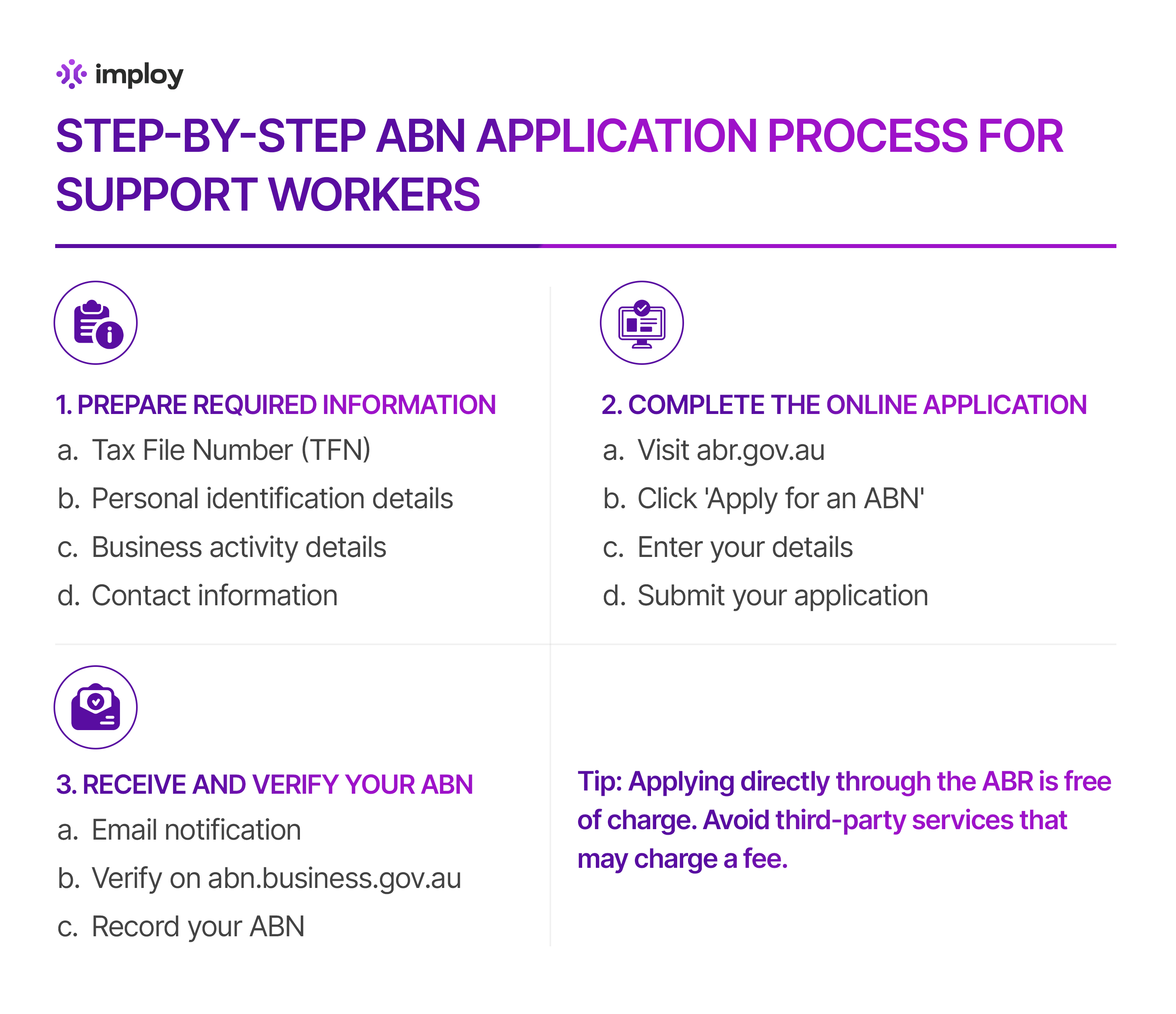How to Get an ABN for Support Workers: A Complete Guide
Learn how to get an ABN as a support worker in Australia. Step-by-step guide, requirements, common mistakes, and what to do after receiving your ABN.

If you’re a support worker looking to operate independently, subcontract through agencies, or work directly with NDIS participants, one of the first things you’ll need is an Australian Business Number (ABN). Having an ABN allows you to invoice clients, register as a sole trader, and legally run your support work as a business.
This guide walks you through exactly how to get an ABN, who needs one, and what to do after you receive it.
What is an ABN?
An Australian Business Number is an 11- digit identifier used by the Australian Government to recognise your business. For support workers, an ABN is essential for:
- Issuing invoices.
- Receiving payments directly from participants or agencies.
- Registering as a sole trader.
- Meeting ATO (Australian Taxation Office) requirements.
- Working with online platforms and marketplaces.
It’s important not to confuse an ABN with other identifiers:
- TFN (Tax File Number): For personal tax.
- ACN (Australian Company Number): Only for registered companies.
Most support workers operate as sole traders, so you’ll simply need an ABN.
Who Needs an ABN as a Support Worker?
You need an ABN if you:
- Work independently with NDIS participants (self-managed or plan-managed).
- Subcontract for disability or aged-care agencies.
- Offer private support services outside a standard employment contract.
- Are starting your own small care-support business.
Important: If you are an employee for a registered provider, you do not need an ABN. The provider handles tax, superannuation, and insurance. Only independent contractors or subcontractors need an ABN. You can read in detail about The Price Guide For Sole Traders on our website.
Requirements Before Applying for an ABN
Before you start, make sure you have:
- Your Tax File Number (TFN).
- Full personal details (address, DOB).
- Contact details (phone, email).
- Business structure - for support workers, choose sole trader.
- Business activity information, such as “Disability Support Services”.
- Business commencement date.
You must confirm that you’re running or intending to run a business. Support work is considered an enterprise if you’re providing services directly to clients.
Step-by-Step ABN Application Process for Support Workers

Starting your journey as a support worker in Australia requires having an Australian Business Number (ABN). Obtaining an ABN is simple and can be done entirely online, allowing you to operate legally, invoice clients, and receive payments as a registered sole trader or business. Following a clear step-by-step process ensures you avoid delays and get your ABN quickly.
Here is a Step-by-Step ABN Application Process for Support Workers:
Step 1: Prepare Required Information
Before starting your application, gather:
- Tax File Number (TFN).
- Personal identification details (name, date of birth, address).
- Business activity details (e.g., “Disability Support Services”).
- Contact information (phone, email).
- Business structure - usually sole trader.
Having all information ready ensures a fast and accurate application.
Step 2: Complete the Online Application
1. Go to the official Australian Business Register (ABR) website: www.abr.gov.au.
2. Click “Apply for an ABN”.
3. Create a myGovID if you don’t already have one and log in.
4. Follow the prompts to enter your details:
- Personal information (name, DOB, TFN).
- Business structure (typically “sole trader”).
- Business activity (e.g., “Disability Support Services”, “Aged Care Support”).
- Business commencement date.
- Contact information.
- Industry code (ANZSIC), such as Personal Care Services or Healthcare.
5. Review all information carefully and submit your application.
Step 3: Receive and Verify Your ABN
- Most applications are processed within 1-2 business days.
- You will receive email notification when your ABN is issued.
- Verify your ABN on ABN Lookup: www.abn.business.gov.au.
- Record your ABN for use on invoices, service agreements, and tax documentation.
Tip: Applying directly through the ABR is free of charge. Avoid third-party services that may charge a fee.
By following these steps, you can secure your ABN quickly and confidently, allowing you to focus on delivering high-quality support services. A properly registered ABN is the first step toward establishing a professional, legally compliant business as a support worker.
Common Mistakes to Avoid
When applying for an Australian Business Number (ABN), attention to detail is crucial. Small mistakes can lead to delays or even rejection, so understanding common pitfalls is the first step toward a smooth application process.
To ensure fast approval, avoid:
- Applying without a genuine business activity.
- Selecting the wrong business structure.
- Using a business name without registering it.
- Providing inconsistent personal details.
- Leaving required fields blank.
By taking the time to prepare accurate information and double-check your application, you can avoid unnecessary delays and start your business journey on the right foot. Following these simple precautions ensures your ABN application is processed quickly and efficiently.
What to Do After You Receive Your ABN?
Receiving your Australian Business Number (ABN) is an important milestone for any support worker. It officially allows you to operate as a registered business and start providing services to clients. However, obtaining your ABN is just the beginning, there are several important steps to take to ensure your business is compliant, protected, and set up for success.
Once you have your ABN, consider these next steps:
1. Register for GST (if required)
GST registration is only mandatory if you earn over $75,000 per year.
2. Set Up Invoicing
You’ll need to invoice clients or plan managers under your ABN. Platforms like Imploy can automate compliant invoicing for NDIS workers.
3. Understand Your Tax Obligations
As a sole trader, you must:
- Declare your business income
- Set aside money for tax
- Track expenses for deductions
4. Get Insurance
Most independent support workers need:
- Public liability insurance
- Professional indemnity insurance
5. Complete Necessary Checks
Depending on your work, you may also need:
- NDIS Worker Screening Check. Learn more about NDIS Worker Screening Check on our website.
- Police Check.
- Working With Children Check.
- First Aid & CPR certifications.
Taking these steps ensures that you are fully prepared to operate your business safely and legally. By registering for GST if needed, setting up proper invoicing, understanding your tax obligations, obtaining the right insurance, and completing all required checks, you can focus on delivering quality support services with confidence and peace of mind.
Final Thoughts
Getting an ABN is the first step toward operating as an independent support worker in Australia. It opens the door to legal invoicing, business compliance, and professional growth. By following the steps outlined in this guide, avoiding common mistakes, and leveraging tools like Imploy for administration and compliance, you can confidently establish your business, focus on delivering high-quality support, and enjoy the independence and flexibility of running your own enterprise.
FAQs
1. What is an ABN and why do I need one?
An ABN (Australian Business Number) is an 11-digit identifier issued by the Australian Government to recognise your business. Support workers need an ABN to invoice clients, receive payments, and operate as an independent contractor or sole trader.
2. Do I need an ABN if I work for an agency?
No. If you are an employee of a registered provider or agency, they handle your tax, superannuation, and insurance. An ABN is only required for independent contractors or subcontractors.
3. How long does it take to get an ABN?
Most ABN applications are processed within 1-2 business days. You’ll receive notification via email, and you can verify it on ABN Lookup.
4. Is there a cost to apply for an ABN?
No. Applying directly through the Australian Business Register (ABR) is free. Avoid third-party services that charge fees.
5. What business structure should I choose as a support worker?
Most support workers operate as sole traders, which is simple, flexible, and suitable for small-scale care services.
6. Do I need to register for GST?
GST registration is only required if your business earns over $75,000 per year. If your earnings are below this threshold, registration is optional.
7. What checks and certifications do I need after getting an ABN?
Depending on your work, you may need:
- NDIS Worker Screening Check.
- Police Check.
- Working With Children Check.
- First Aid & CPR certifications.
8. How can Imploy help me after getting an ABN?
Imploy helps support workers with automated invoicing, payment tracking, expense management, compliance storage, and reporting - making business administration simpler and more efficient.





